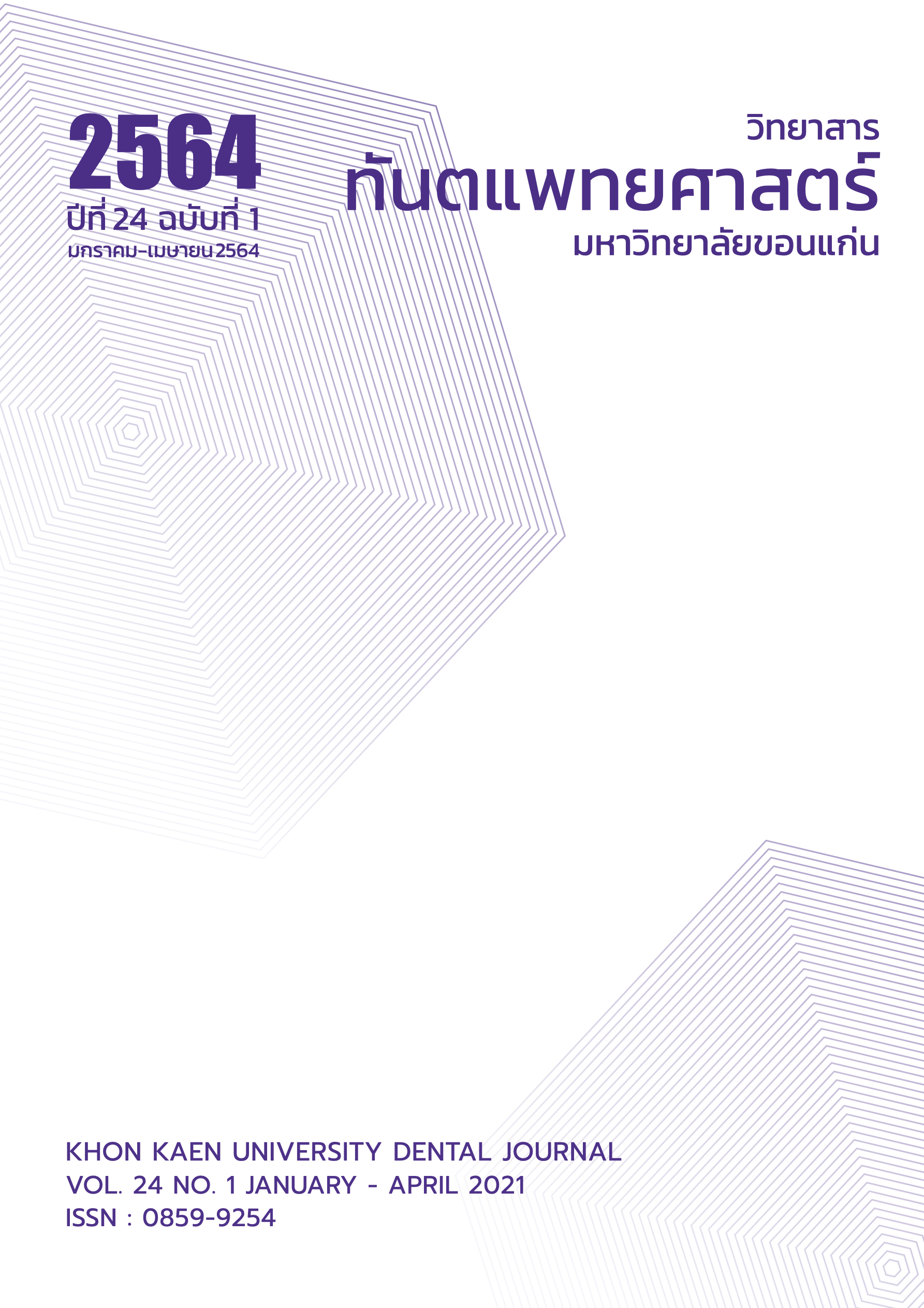A Comparison of Five Conducting Media for Length Determination of Electronic Apex Locator Using a Simulation Model
Main Article Content
Abstract
The aim of this study was to compare five conducting media for length determination of electronic apex locator using a simulation model. Fifty plastic teeth were performed the access opening and mounted in simulation models. Simulation models were constructed with a clear acrylic tube (8 mm. in diameter) filled with conducting media in a clear acrylic box (50x50x30 mm). They were randomly allocated into 5 groups (n=10) according to the conducting media used which were 0.9% sodium chloride (NaCl), 2.5% sodium hypochlorite (NaOCl), 2% chlorhexidine (CHX), 17% ethylenediamine tetraacetic acid (EDTA), and cell culture medium (Minimum Essential Medium, MEM). The working length of each tooth was recorded visually (actual working length, AWL) and measured by an electronic apex locator at 0.5 bar (electronic working length, EWL). The mean differences between AWL and EWL were calculated and statistically compared among groups with one-way ANOVA, followed by Tukey’s HSD test (p<0.05). Results showed that the mean differences in the 0.9% NaCl and MEM groups were significantly lower than the 2.5% NaOCl, 2% CHX and 17% EDTA groups. Under the limitations of this study, 0.9% NaCl and MEM were suitable conducting media for length determination of electronic apex locator using a simulation model.
Article Details
บทความ ข้อมูล เนื้อหา รูปภาพ ฯลฯ ที่ได้รับการลงตีพิมพ์ในวิทยาสารทันตแพทยศาสตร์ มหาวิทยาลัยขอนแก่นถือเป็นลิขสิทธิ์เฉพาะของคณะทันตแพทยศาสตร์ มหาวิทยาลัยขอนแก่น หากบุคคลหรือหน่วยงานใดต้องการนำทั้งหมดหรือส่วนหนึ่งส่วนใดไปเผยแพร่ต่อหรือเพื่อกระทำการใด ๆ จะต้องได้รับอนุญาตเป็นลายลักษณ์อักษร จากคณะทันตแพทยศาสตร์ มหาวิทยาลัยขอนแก่นก่อนเท่านั้น
References
Nekoofar MH, Ghandi MM, Hayes SJ, Dummer PM. The fundamental operating principles of electronic root canal length measurement devices. Int Endod J 2006; 39(8):595-609.
Wu MK, Wesselink PR, Walton RE. Apical terminus location of root canal treatment procedures. Oral Surg Oral Med Oral Pathol Oral Radiol Endod 2000;89(1): 99-103.
Kuttler Y. Microscopic investigation of root apexes. J Am Dent Assoc 1955;50(5):544-52.
Tinaz AC, Alaçam T, Topuz O. A simple model to demonstrate the electronic apex locator. Int Endod J 2002;35(11):940-5.
Chen E, Kaing S, Mohan H, Ting SY, Wu J, Parashos P. An ex vivo comparison of electronic apex locator teaching models. J Endod 2011;37(8):1147-51.
Herbert J, Buchmann G. New multipurpose endodontic device developed in Germany for use in predoctoral and continuing dental education and science. J Dent Educ 2012;76(6):759-64.
Vajrabhaya L, Korsuwannawong S. The correlation between electronic and radiographic working length determination in resin model: a laboratory study. J Dent Assoc Thai 2013;63(3):129-36.
Alshwaimi EO, Narayanraopeta UB. Effect of time on electronic working length determination with a novel endodontic module in preclinical endodontic training. Saudi J Med Sci 2014;2(1):37-42.
Kaufman AY, Keila S, Yoshpe M. Accuracy of a new apex locator: an in vitro study. Int Endod J 2002; 35(2):186-92.
Baldi J, Victorino F, Bernardes R, Moraes I, Bramante C, Garcia R, Bernardineli N. Influence of embedding media on the assessment of electronic apex locators. J Endod 2007;33(4):476-9.
Tchorz JP, Hellwig E, Altenburger MJ. Teaching model for artificial teeth and endodontic apex locators. J Dent Educ 2013;77(5):626-9.
Czerw RJ, Fulkerson MS, Donnelly JC. An in vitro test of a simple model to demonstrate the operation of electronic root canal measuring devices. J Endod 1994; 20(12):605-6.
Guise GM, Goodell GG, Imamura GM. In vitro comparison of three electronic apex locators. J Endod 2010;36(2):279-81.
Nahmias Y, Aurelio JA, Gerstein H. An in vitro model for evaluation of electronic root canal length measuring devices. J Endod 1987;13(5):209-14.
Mello-Moura ACV, Bresolin CR, Moura-Netto C, Ito A, Araki AT, Imparato JCP, Mendes FM. Use of artificial primary teeth for endodontic laboratory research: experiments related to canal length determination. BMC Oral Health 2017;17(1):131.
Shabahang S, Goon W, Gluskin A (1996) An in vivo evaluation of Root ZX electronic apex locator. J Endod 22:616–8.
Yao T, Asayama Y. Animal-cell culture media: History, characteristics, and current issues. Reprod Med Biol 2017;16(2):99-117.
Biosera.com [Homepage on internet]: Biosera North America; Available from: http://www.biosera.com/ home/products/mem/#:~:text=MEM%20%CE%B1%20is%20a%20modification,%2C%20biotin%2C%20and%20ascorbic%20acid.
Sauerheber R, Heinz B. Temperature effects on conductivity of seawater and physiologic saline, mechanism and significance. Chem Sci J 2015;6(4):1-5.
Leonardo MR, Silva LA, Nelson-Filho P, Silva RA, Raffaini MS. Ex vivo evaluation of the accuracy of two electronic apex locators during root canal length determination in primary teeth. Int Endod J 2008;41(4): 317-21.
Mazzoleni A, Sisken B, Kahler R. Conductivity values of tissue culture medium from 20-degree C to 40-degree C. Bio electromagnetics 1986;7(1):95-9.
Shin HS, Yang WK, Kim MR, Ko HJ, Cho KM, Park SH, et al. Accuracy of Root ZX in teeth with simulated root perforation in the presence of gel or liquid type endodontic irrigant. Restor Dent Endod 2012;37(3): 149-54.
Culkin F. Calibration of standard seawater in electrical conductivity. Sci Total Environ 1986;49:1-7.
Seoane F. Electrical Bioimpedance Cerebral Monitoring: Fundamental steps towards Clinical application. Electrical Bioimpedance Cerebral Monitoring: Fundamental Steps towards Clinical Application. 2007. PhD thesis, University College of Boras, Boras, Sweden.
Jain A. Body fluid composition. Pediatr Rev 2015; 36(4): 141-50.


